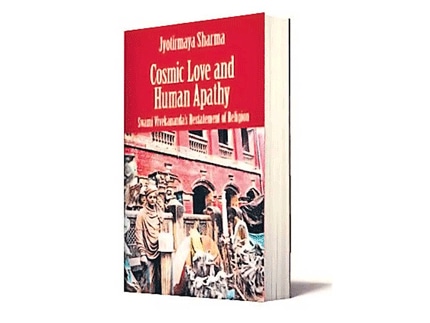Fork in the path
Swami Vivekananda is a mean guy. Nearly a year after his guru Ramakrishna dies he addresses the devotees of the monastic order named after the departed sage. Here, he mimics Ramakrishna, who hallucinated in his last years.
Cosmic Love and Human Apathy

Swami Vivekananda’s Restatement of Religion
Jyotirmaya Sharma
Harper Collins
Rs. 499 * 300 pp
Swami Vivekananda is a mean guy. Nearly a year after his guru Ramakrishna dies he addresses the devotees of the monastic order named after the departed sage. Here, he mimics Ramakrishna, who hallucinated in his last years.
Vivekananda opens his mouth and then in the manner of Ramakrishna gobbles a sweet. He imitates Ramakrishna’s well-known samadhi-like posture and avoids the helping hand of a follower. Then he says, in a spot-on Ramakrishna drawl “I-am-all-right.”
The crowd erupts in laughter. Their acceptance of their new leader appears complete. Vivekananda’s jibe at Ramakrishna is imperative to author Jyotirmaya Sharma.
It maps the fork in the spiritual path that both men took and diverged from. Ramakrishna worshipped goddess Kali and vested her image with virtues of love. Vivekananda wanted Hindus to move away from Kali and turn to Krishna.
In Ramakrishna’s outlook, people of all religions were equal; only the love of God mattered. For Vivekananda, India’s Hindu identity was most important. To Ramakrishna, acts of charity and “doing good” were expressions of egoism.
For Vivekananda, altruism rejuvenated a spiritually bankrupt Hinduism in colonised India. Ramakrishna had no cut-and-dried views on British rule.
Vivekananda, in his complicated imagination, wanted to construct a “traditional” India that absorbed the best of Greek and European civilization.
Ramakrishna rarely spoke about caste or Islam. Vivekananda believed in the varna system, in Aryan and Brahmin supremacy — with caveats — while Islam for him, was decidedly inferior to Hinduism. At one point, Vivekananda — quite the master of self-contradiction — prescribes beef-eating and muscle-building as a way of reviving the (Hindu) nation.
It’s a mystery how the catholic Ramakrishna indulged and anointed the hard-line Vivekananda after facing the latter’s ridicule in public.
This is a work of historical research that is quintessentially a close reading of the arguments on spirituality, Hinduism, European civilization, caste, religion etc. between Vivekananda and Ramakrishna and of how Vivekananda fashioned his edition of Hinduism by intentionally misconstruing his guru.
Political scientist Jyotirmaya Sharma works like an investigative reporter on a beat that is the life of Ramakrishna and Vivekananda. His sources are the speeches, writings and accounts on both men from devotees, and his journalistic temperament bestows the narrative grip, pace and ease.
Sharma’s reporting ability from the archives on Bengal’s spiritual rock stars of the late 19th century is not under question. We get the vibrant tussles that the duo had on the issues of the day.
Sharma’s got a nimble handle on the Hindu philosophical traditions that Ramakrishna and Vivekananda tap into and that helps to place some of their deliberations in perspective. However, we are denied a view of the wider social milieu of which they were a part.
To vivify the intellectual disparities of two major religious figures is impressive. Understanding how their contemplation filtered down to their target audience is just as germane.
The second question becomes pertinent as Ramakrishna and Vivekananda were at loggerheads so often. How did followers respond to Vivekananda’s prescription of beef consumption or embrace of Western civilization? How did they react to the switch from Kali to Krishna? Weren’t they surprised at Vivekananda’s distortions of Ramakrishna’s ideas? How did Bengali Muslims respond to Vivekananda’s thoughts? What was the lower caste response to his reinforcing varna? In short, how was Vivekananda’s restatement of religion received?
When Sharma tips his hat to others’ work from the bulwark that is Bengali social history of the 19th century he provides some context. But largely he hermetically controls the story line which is a jugalbandi on the assertions of these two men.
It’s a double-edged advantage. For, with these curbs, we get a focused work. If Sharma had chosen to answer questions about Ramakrishna’s and Vivekananda’s impact, we may have had a history of more heft. On current evidence, Sharma the reporter of the archives wins.
Sharma the political scientist-cum-historian has settled for a draw.
Rahul Jayaram is an independent journalist.





